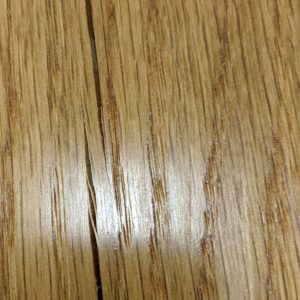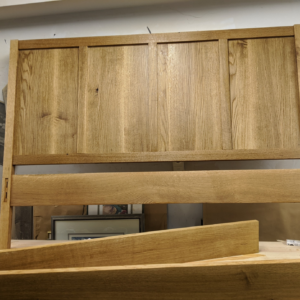I’m fairly new to woodworking. Lets get this out of the way.
I designed and recently built a bed with white oak. More or less I was quite happy with the build. Today I went to add final coat of finish when I noticed a crack running down the grain. The panels have Rabbets cut to fit frames exactly. I’m not sure if this is a design flaw or not causing the crack. Would it have been better to cut a dado wide enough to fit entire thickness of panel?
I want to rebuild this, just don’t want to make the same mistake twice
Discussion Forum
Get It All!
UNLIMITED Membership is like taking a master class in woodworking for less than $10 a month.
Start Your Free TrialCategories
Discussion Forum
Digital Plans Library
Member exclusive! – Plans for everyone – from beginners to experts – right at your fingertips.
Highlights
-
Shape Your Skills
when you sign up for our emails
This site is protected by reCAPTCHA and the Google Privacy Policy and Terms of Service apply. -
 Shop Talk Live Podcast
Shop Talk Live Podcast -
 Our favorite articles and videos
Our favorite articles and videos -
E-Learning Courses from Fine Woodworking
-
-
 Fine Woodworking New England Event
Fine Woodworking New England Event -














Replies
A small amount of glue squeeze out inside the corners in the frame assembly can cause this. The glue sticks the panel to the frame, when it shrinks something has to give, usually the panel. A wider groove won't stop this. You have to use the glue sparingly and keep it away from the edges of the panels. You can also apply a little paraffin on the edges at the corners as some insurance.
So in other words, the panel should float inside the frame freely?
That is correct. Each panel needs to be able move across it's width with changes in humidity. Which also means the panels should have finish applied to them before assembly so in the winter, when the panels "shrink", there won't be any unfinished panel sections exposed.
If you built it recently 27B is probly correct... the panel was kept from shrinking by glue as the dry winter set in. The flip side would be building to a tight fit in winter and having the panels expand and blow the structure up as the summer humidity arrives.
The panel SHOULD float freely, but with an eye on where it is, and where it is going over time.
You need to allow room for wood movement, the wood is trying to expand but it can’t so it’s blowing apart. Wood only moves across it’s width, almost not at all in length. Many people suggest about 1/4 inch per foot. So in your case, you need the rabbit to be deep enough to allow each panel to expand and contract more than that and no glue or fasteners confining that panel. The panel needs to be prefinished so that the movement doesn’t expose an unfinished edge when it shrinks as well.
In your design, the back of the panel could be rabbited as well to allow it to move into and out of your groove, that way you can allow for lots of movement without changing your design. (which is beautiful by the way!)
Also take into consideration the time of year and location that you’re building in to know if your wood is already expanded or already contracted as you’re calculating. Right now, in northern areas with heat on, wood is at it’s most contracted. Mid summer, lots of humidity, it will be fully expanded.
Hope that helps! Don’t be discouraged, that’s a great project!!
Maybe there is someone here that is an expert on the subject. I am not but, I don't think the cracks have anything to do with seasonal wood movement. I think it is "ring shake". Here is a definition I found:
"Shake – A lengthwise crack or separation of the wood between the growth rings, often extending along the board’s face and sometimes below its surface. Shakes may either partly or completely separate the wood fibers. The separations make the wood undesirable when appearance is important. Although this is a naturally occurring defect possibly caused by frost or wind stress, shakes can also occur on impact at the time of felling and because of shrinkage in the log before conversion.
There are two types of shakes:
● Star Shake: A group of splits radiating from the pith or center of the tree in the form of a star. It is wider on the outside ends and narrower on the inside ends. Star shakes are usually formed due to extreme heat or severe frost during the tree’s growth. Also referred to as heart shake.
● Ring Shake: Also known as “cup shake” or “wind shake,” this rupture runs parallel to the growth rings. A ring shake is not easily detected in green logs and lumber, but only becomes apparent after drying. It’s caused by any one of numerous factors, including bacteria, tree wounds, tree age, and environmental conditions such as excessive frost action on the sap when the tree is young."
I suggest you not do anything for a while (maybe a year to let it go through a complete cycle of seasonal changes). Then, if it doesn't get worse, fill the cracks with epoxy tinted to match the darker parts of the grain. From 5' away, you will not even know they are there. If you are real careful, you may not even disturb the existing finish.
Nice work, by the way.
Thanks for all the feedback!!
Very nice work and to chime in agreement with Bilyo and others: I wouldn't do anything for while and see what happens. Finish the project, ignore the defect (hard to do), and revisit in a year.
I agree with @bilyo - this is not a typical wood movement crack - those tend to follow one grain rather than as this one has, multiple.
I think it is inherent to the piece of wood and may or may not sort itself out. As others have said, leave well alone.
You are the only person who will ever see the crack, especially if you fill it with some suitable filler if it doesn't go away.
On the panels, I had one crack recently because I had machined it a little tight in the groove. Movement caused it to bind, then to crack. Easy to fix with a chisel as a lever and some glue, but annoying nonetheless...
This forum post is now archived. Commenting has been disabled